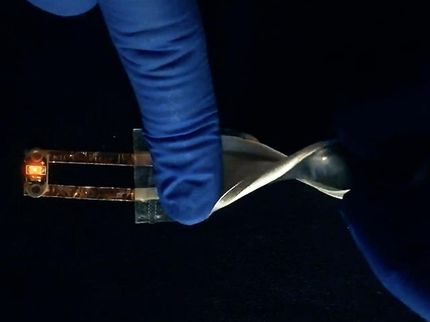The first washable battery
Stretchy, washable battery brings wearable devices closer to reality
UBC researchers have created what could be the first battery that is both flexible and washable. It works even when twisted or stretched to twice its normal length, or after being tossed in the laundry.

Dr. Ngoc Tan Nguyen and his colleagues have created a battery that is both flexible and washable. It works even when twisted or stretched to twice its normal length, or after being washed multiple times.
Kai Jacobson
“Wearable electronics are a big market and stretchable batteries are essential to their development,” says Dr. Ngoc Tan Nguyen, a postdoctoral fellow at UBC’s faculty of applied science. “However, up until now, stretchable batteries have not been washable. This is an essential addition if they are to withstand the demands of everyday use.”
The battery developed by Dr. Nguyen and his colleagues offers a number of engineering advances. In normal batteries, the internal layers are hard materials encased in a rigid exterior. The UBC team made the key compounds—in this case, zinc and manganese dioxide—stretchable by grinding them into small pieces and then embedding them in a rubbery plastic, or polymer. The battery comprises several ultra-thin layers of these polymers wrapped inside a casing of the same polymer. This construction creates an airtight, waterproof seal that ensures the integrity of the battery through repeated use.
It was team member Bahar Iranpour, a PhD student, who suggested throwing the battery in the wash to test its seal. So far, the battery has withstood 39 wash cycles and the team expects to further improve its durability as they continue to develop the technology.
“We put our prototypes through an actual laundry cycle in both home and commercial-grade washing machines. They came out intact and functional and that’s how we know this battery is truly resilient,” says Iranpour.
The choice of zinc and manganese dioxide chemistry also confers another important advantage. “We went with zinc-manganese because for devices worn next to the skin, it’s a safer chemistry than lithium-ion batteries, which can produce toxic compounds when they break,” says Nguyen.
An affordable option
Ongoing work is underway to increase the battery’s power output and cycle life, but already the innovation has attracted commercial interest. The researchers believe that when the new battery is ready for consumers, it could cost the same as an ordinary rechargeable battery.
“The materials used are incredibly low-cost, so if this is made in large numbers, it will be cheap,” says electrical and computer engineering professor Dr. John Madden(he/him), director of UBC’s Advanced Materials and Process Engineering Lab who supervised the work. In addition to watches and patches for measuring vital signs, the battery might also be integrated with clothing that can actively change colour or temperature.
“Wearable devices need power. By creating a cell that is soft, stretchable and washable, we are making wearable power comfortable and convenient.”
Original publication
Other news from the department science
Most read news
More news from our other portals
See the theme worlds for related content
Topic World Battery Technology
The topic world Battery Technology combines relevant knowledge in a unique way. Here you will find everything about suppliers and their products, webinars, white papers, catalogs and brochures.

Topic World Battery Technology
The topic world Battery Technology combines relevant knowledge in a unique way. Here you will find everything about suppliers and their products, webinars, white papers, catalogs and brochures.




























































